
3 minute read
Government Grants $50 Million for Australian Scientists Pioneering World’s First Long-Term Artifcial Heart
In a landmark initiative poised to revolutionize cardiovascular medicine, Australian scientists are spearheading the development of the world’s frst longterm artifcial heart. With a signifcant boost from the federal government, which has pledged a grant of $50 million towards the project, researchers are advancing towards a transformative breakthrough in cardiac care.
The artifcial heart, conceptualized as an off-the-shelf alternative to organ donation, holds immense promise for patients suffering from end-stage heart failure. For individuals like Jayden Cummins, whose life was irrevocably altered by a viral infection that led to severe heart deterioration, the prospect of a long-term solution represents a beacon of hope.
Cummins, a Sydneybased flmmaker, vividly recounts his battle with heart failure, attributing it to a viral assault that left him operating at a mere 7 percent heart function. While he underwent a temporary solution with a Left Ventricular Assist Device (LVAD) followed by a heart transplant, his journey underscores the critical need for innovative interventions to address the scarcity of donor organs. Enter Dr. Daniel Timms and his team of bio scientists, who’s pioneering BiVACOR Total Artifcial Heart promises to be a gamechanger in the feld of cardiac medicine. Unlike conventional devices that mimic the pumping action of the natural heart using balloons prone to wear and tear, the BiVACOR heart utilizes magnetic levitation technology to propel blood circulation effciently.
Dr. Timms elucidates on the innovative design, likening it to the magnetically levitated trains in Japan and China, which ensure smooth and frictionless motion. Supported by a multidisciplinary team, including Associate Professor Shaun Gregory of Monash University’s Artifcial Heart Frontiers Program, the project unfolds with regular visits to the local hardware store, where components for heart replication are sourced.
The journey from laboratory benchtops to animal testing has yielded promising results, with the titanium hearts demonstrating remarkable durability and effcacy. Human trials are slated to commence in the United States later this year, marking a signifcant milestone in the quest for a viable long-term solution to heart failure.
Professor Garry Jennings from the Heart Foundation of Australia underscores the urgency of such innovations, citing the stark reality of organ shortages and the pressing need for alternatives. With heart failure claiming one in 50 Australian lives annually and a limited number of heart transplant procedures performed each year, the advent of artifcial hearts offers a lifeline to countless patients awaiting salvation.
The federal government’s generous funding injection signals a resounding vote of confdence in Australia’s scientifc prowess and commitment to advancing medical innovation. With hopes pinned on accelerated progress, scientists aim to make these groundbreaking devices available to patients within the next few years, heralding a new era of cardiac care.
For transplant recipient Jayden Cummins, the potential impact of compassion. With each beat of progress, the collective hope is for a future where life-saving technology transcends boundaries, enriching and extending lives with boundless possibility. these advancements is profound. Refecting on his journey posttransplant, Cummins marvels at the newfound lease on life, cherishing precious moments with loved ones made possible by the gift of a donor heart. His story serves as a poignant reminder of the transformative power of medical innovation and the enduring spirit of resilience in the face of adversity.
As Australia embarks on this bold frontier of medical innovation, the promise of artifcial hearts offers solace to those grappling with the debilitating effects of heart failure, embodying the triumph of human ingenuity and
1. Revolutionary Technology: The BiVACOR Total Artifcial Heart represents a groundbreaking advancement in cardiovascular medicine. Unlike conventional devices that mimic the pumping action of the natural heart using balloons prone to wear and tear, the BiVACOR heart utilizes magnetic levitation technology for effcient blood circulation. This innovative design, inspired by magnetically levitated trains in Japan and China, promises enhanced durability and effcacy, offering hope to countless patients grappling with end-stage heart failure.
2. Government Funding: The federal government’s pledge of $50 million towards the project underscores its commitment to advancing medical innovation and improving healthcare outcomes. This substantial investment not only signifes confdence in Australia’s scientifc prowess but also accelerates progress towards making artifcial hearts available to patients within the next few years. Such funding injections play a pivotal role in driving research initiatives and fostering collaboration between academia, industry, and government entities.

3. Human Impact: Jayden Cummins’ personal journey serves as a poignant testament to the transformative potential of medical innovation. Having navigated the harrowing challenges of endstage heart failure and subsequent transplantation, Cummins embodies resilience and hope. His story highlights the profound impact of artifcial hearts on patients’ lives, offering a lifeline to individuals awaiting organ transplantation. Through advancements in medical technology, Cummins and countless others fnd solace and renewed optimism for the future, underscoring the profound human dimension of scientifc progress.











